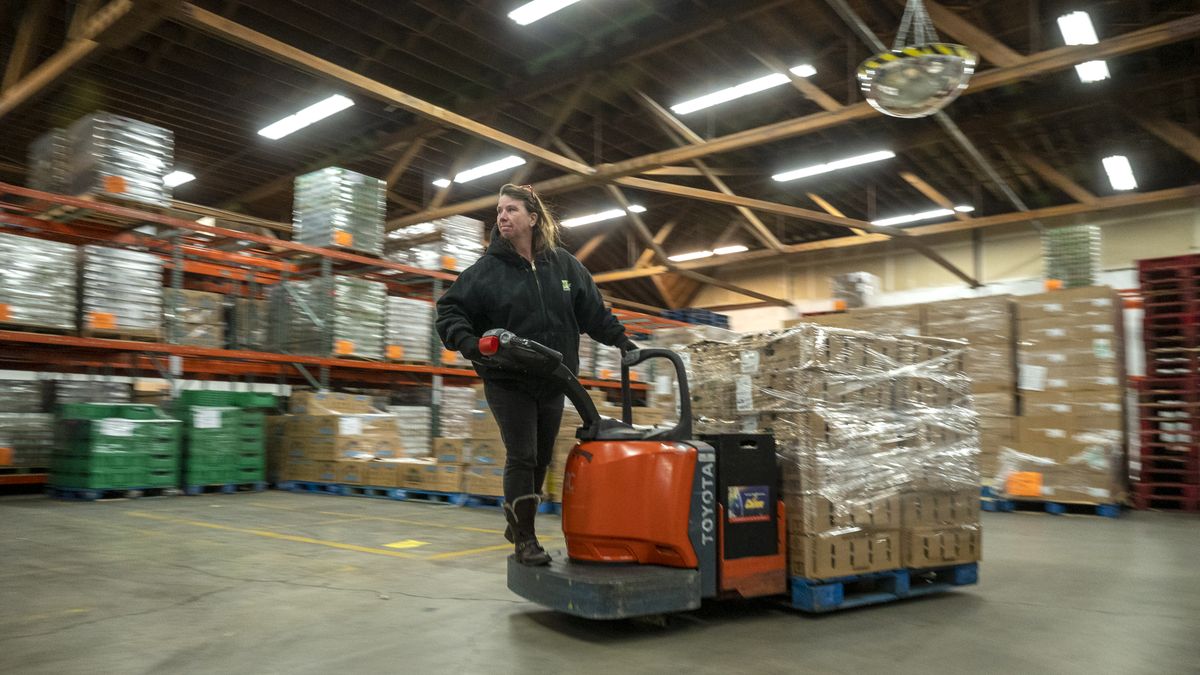Soaring food prices and lower crop yields cause shortfalls at Spokane’s Second Harvest sees higher demand
Barbara Kent maneuvers pallets of food using a pallet jack at the Second Harvest warehouse Nov. 7, 2022 in Spokane. The regional food bank supply distributor is facing higher prices and some shortages in produce and commodities. (Jesse Tinsley/THE SPOKESMAN-REVI)
At Second Harvest’s warehouse in Spokane last week, Eric Williams walked by areas with empty shelves that are normally filled with shelf-stable products.
While the regional food bank supplier typically has an ebb and flow in stockpiles for distribution, the nonprofit is suddenly facing a vexing problem: “Crop yields are down, the number of people using food banks and pantries is up, and of course inflation is hitting way too many people way too hard,” said Williams, the nonprofit’s community partnership director.
He said the nonprofit has supplies for this month – and also with advanced buying – enough for regional turkey drives. But winter tends to bring higher demand.
Typically about 30% of Second Harvest’s food supplies comes from farmers’ produce donations, but that’s down due to smaller regional harvests, California’s drought and rising costs for growers.
Another source, at slightly more than 30%, comes from what’s called grocery rescue, which can include stores’ extras or items being rotated out. Grocery rescue remains at about the same level.
Food drives bring 2% to 5%, but were down as schools and offices closed with COVID-19. Government funding and food purchases have returned to about the 10-15% level that was common prior to the pandemic, Williams said. To acquire additional food, Second Harvest uses its donated dollars to buy groceries to distribute.
“We go out and actually buy a relatively modest amount of food, but we’re suddenly having to buy more food than normal,” Williams said. “For example last month, we spent $500,000 more than normal to help shore up our warehouses. It was necessary but it’s unsustainable. We can’t do another $500,000 every month.”
Second Harvest supplies 280 food pantries and meal sites in North Idaho and Central and Eastern Washington. In a recent survey of 150 larger sites, operators reported a 45% increase in the number of people seeking help in the year between September 2021 and 2022.
Anecdotally, many first-time recipients told operators that inflation is the reason why they’re at pantries, Williams said. In the past 12 months, U.S. households saw a 13% increase in price of groceries.
There are other issues pressing against families and agencies trying to fight food insecurity, Williams added.
“Fuel costs haven’t directly affected the amount of food but certainly the cost,” he said. While gasoline prices have gone down somewhat in the past month, diesel prices remain high.
“A couple of weeks ago, I was talking to one of our semi drivers and he’d just fueled up. It was $906 when it was normally more like $500,” for Second Harvest’s distribution trucks.
Williams noted that most farm vehicles like tractors use diesel as do most trucks that transport food.
He said dollar donations to Second Harvest remain steady, which aids its buying of food supplies for distribution. Williams credits the generosity of donors and volunteers.
Meanwhile, he said government funding and food supplies that rose during the pandemic have returned to normal levels, but pantry use remains high. During the pandemic, government assistance went “north of 40%” toward supplies, including Spokane County distributing about $9 million in CARES Act funding, Williams said.
“The pandemic hit and a couple months later there was a big flush of food that came from local, state and federal government, so there was high need then, but a lot of food was pushed into the system.
“Well, now inflation has hit and most of those programs that were pandemic-induced aren’t around anymore so we have even higher need and also way less backstop from government programs.”
However, the outlook is good for this month’s regional turkey drives in Spokane and Tri-Cities, including Tom’s Turkey Drive in Spokane, thanks to advanced buying and planning.
“Our supply chain team and Rosauers ordered the turkeys for the turkey drives in January,” he said. “We have the turkeys for the drives, about 13,500 turkeys or so.”
In September, Consumer News reported that a resurgence of bird flu wiped out some egg and turkey operations in the heartland of the U.S., and that turkey costs are about 30% higher than a year ago. Inventories of whole turkeys are the lowest going into the winter holiday season since 2006.
Each year, Second Harvest distributes about 32 to 35 million pounds of food. At the pandemic’s height, that reached 52 million pounds in one year, Williams said.
A recent Feeding America report estimated with 2020 data that about 214,000 people in the Inland Northwest experience food insecurity. Feeding America is a national network of more than 200 food banks, including Second Harvest.
“There is always an ebb and flow, but right now there is a little more ebbing than we’d like to see,” Williams said.
“Because of higher prices, less availability and higher need, it’s a trilemma of things that we’re working through. Oftentimes, I’m asked ‘Is it better to give money or food?’ Right now, the answer is ‘Yes.’ ”


